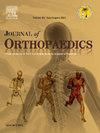Direct anterior total hip arthroplasty after hip arthroscopy: A retrospective review
IF 1.5
Q3 ORTHOPEDICS
引用次数: 0
Abstract
Introduction
Limited studies have investigated outcomes of total hip arthroplasty (THA) after ipsilateral hip arthroscopy, with mixed conclusions. There is need to provide clarity on potential risks/complications associated with this sequence of operations.
Methods
This is a retrospective single surgeon cohort study, evaluating patients from 01/01/2012–01/01/2020 undergoing direct anterior THA for osteoarthritis, with minimum 90-day follow-up. There were two groups: previous hip arthroscopy plus THA (THA+) and isolated THA (control) without previous hip arthroscopy. All THA + patients had undergone one previous hip arthroscopy prior to THA. Quantitative variables were evaluated using the Mann-Whitney-U test or a two-tailed unpaired t-test. Nominal variables were evaluated using the chi-square or Fisher's Exact test. Significance was assessed at p < 0.05.
Results
Seventy-one patients were included, 38 patients in the THA + group, and 33 patients in the control group. Surgery duration was longer in the THA + group (74 min THA + [SD = 9.5], 60 min control [SD = 11.3], p < 0.0001). The only secondary outcome with significance was average estimated blood loss (400 mL THA+, 275 mL control, p = 0.009). Only one THA + patient required postoperative transfusion (p = 1.0). There were no postoperative deep infections requiring debridement, intra-operative fractures requiring fixation, or postoperative dislocations in either group. The THA group had one post-operative fracture requiring surgery. The THA + group was younger (average) than the control group (52 THA + [SD = 9.9], 58.4 control [SD = 8.8], p = 0.0062).
Conclusion
This study highlights increased operative time and estimated blood loss after previous ipsilateral hip arthroscopy. Surgeons should recognize implications on time management, and assist surgeons when deciding to perform a THA at a surgery center vs hospital. These results contribute to a growing body of literature indicating no increase in major complication rate of THA after ipsilateral hip arthroscopy.
髋关节镜后直接前路全髋关节置换术:回顾性回顾
有限的研究调查了同侧髋关节镜术后全髋关节置换术(THA)的结果,结论不一。有必要明确与该手术顺序相关的潜在风险/并发症。方法回顾性单外科医生队列研究,评估2012年1月1日至2020年1月1日接受骨关节炎直接前路THA治疗的患者,随访至少90天。有两组:既往髋关节镜联合THA组(THA+)和未既往髋关节镜单独THA组(对照组)。所有THA +患者在THA前均接受过一次髋关节镜检查。定量变量采用Mann-Whitney-U检验或双尾非配对t检验进行评估。名义变量采用卡方检验或费雪精确检验进行评估。p <评估显著性;0.05.结果纳入71例患者,THA +组38例,对照组33例。THA +组手术时间更长(THA +组74分钟[SD = 9.5],对照组60分钟[SD = 11.3], p <;0.0001)。唯一有意义的次要终点是平均估计失血量(400 mL THA+, 275 mL对照,p = 0.009)。只有1例THA +患者术后需要输血(p = 1.0)。两组均无术后需要清创的深部感染、术中需要固定的骨折或术后脱位。THA组有一例术后骨折需要手术。THA +组平均年龄小于对照组(52例THA + [SD = 9.9], 58.4例对照组[SD = 8.8], p = 0.0062)。结论:本研究强调了既往同侧髋关节镜术后手术时间和估计失血量的增加。外科医生应该认识到时间管理的影响,并协助外科医生决定在手术中心还是医院进行THA。这些结果使得越来越多的文献表明同侧髋关节镜术后THA的主要并发症发生率没有增加。
本文章由计算机程序翻译,如有差异,请以英文原文为准。
求助全文
约1分钟内获得全文
求助全文
来源期刊

Journal of orthopaedics
ORTHOPEDICS-
CiteScore
3.50
自引率
6.70%
发文量
202
审稿时长
56 days
期刊介绍:
Journal of Orthopaedics aims to be a leading journal in orthopaedics and contribute towards the improvement of quality of orthopedic health care. The journal publishes original research work and review articles related to different aspects of orthopaedics including Arthroplasty, Arthroscopy, Sports Medicine, Trauma, Spine and Spinal deformities, Pediatric orthopaedics, limb reconstruction procedures, hand surgery, and orthopaedic oncology. It also publishes articles on continuing education, health-related information, case reports and letters to the editor. It is requested to note that the journal has an international readership and all submissions should be aimed at specifying something about the setting in which the work was conducted. Authors must also provide any specific reasons for the research and also provide an elaborate description of the results.
 求助内容:
求助内容: 应助结果提醒方式:
应助结果提醒方式:


